Yes, I’ve been busy, busy, busy. At this point, neither fish has cloudy eyes, both have hearty appetites, but they are still not 100%. Was going to get a skin scrape set up this past week but there’s truly been no time (2 back-to-back trips, wife’s birthday, father’s day in a matter of minutes etc…). The smaller male has had a white spot between his eyes for 8 days now. So yes, the skin scrape for testing is still very much on the table. The most important parts to note is that they’re alive, no imminent danger that I’m aware of, although there has been no breeding behavior now for at least a week, but probably more. That’s all for the time being.
- About The Lightning Project
- Inventory of F1 PNG Lightning and White Stripe Maroon Clownfish
- F1 PNG Lightning Maroon Clownfish, BZLM1
- F1 PNG Lightning Maroon Clownfish, BZLM2
- F1 PNG Lightning Maroon Clownfish, FW1
- F1 PNG Lightning Maroon Clownfish, LM10
- F1 PNG Lightning Maroon Clownfish, LM11
- F1 PNG Lightning Maroon Clownfish, LM12
- F1 PNG Lightning Maroon Clownfish, LM13
- F1 PNG Lightning Maroon Clownfish, LM14
- F1 PNG Lightning Maroon Clownfish, LM15
- F1 PNG Lightning Maroon Clownfish, LM16
- F1 PNG Lightning Maroon Clownfish, LM17
- F1 PNG Lightning Maroon Clownfish, LM18
- F1 PNG Lightning Maroon Clownfish, LM19
- F1 PNG Lightning Maroon Clownfish, LM20
- F1 PNG Lightning Maroon Clownfish, LM3
- F1 PNG Lightning Maroon Clownfish, LM4
- F1 PNG Lightning Maroon Clownfish, LM5
- F1 PNG Lightning Maroon Clownfish, LM6
- F1 PNG Lightning Maroon Clownfish, LM7
- F1 PNG Lightning Maroon Clownfish, LM8
- F1 PNG Lightning Maroon Clownfish, LM9
- F1 PNG Lightning Maroon Clownfish, MD1
- F1 PNG Lightning Maroon Clownfish, MWP3
- F1 PNG Lightning Maroon Clownfish, WS17
- F1 PNG Lightning Maroon, EC1
- F1 PNG Lightning Maroon, GL1
- F1 PNG White Stripe Maroon Clownfish, BZWS1
- F1 PNG White Stripe Maroon Clownfish, BZWS2
- F1 PNG White Stripe Maroon Clownfish, BZWS3
- F1 PNG White Stripe Maroon Clownfish, WS10
- F1 PNG White Stripe Maroon Clownfish, WS11
- F1 PNG White Stripe Maroon Clownfish, WS12
- F1 PNG White Stripe Maroon Clownfish, WS13
- F1 PNG White Stripe Maroon Clownfish, WS14
- F1 PNG White Stripe Maroon Clownfish, WS15
- F1 PNG White Stripe Maroon Clownfish, WS16
- F1 PNG White Stripe Maroon Clownfish, WS4
- F1 PNG White Stripe Maroon Clownfish, WS5
- F1 PNG White Stripe Maroon Clownfish, WS6
- F1 PNG White Stripe Maroon Clownfish, WS7
- F1 PNG White Stripe Maroon Clownfish, WS8
- F1 PNG White Stripe Maroon Clownfish, WS9
- F1 PNG White Stripe Maroon, EC2
- F1 PNG White Stripe Maroon, FW2
- F1 PNG White Stripe Maroon, GL2
- F1 PNG White Stripe Maroon, MD2
- Lightning Breeding Directive
- Lightning Maroon Clownfish Links
- Home
- About The Lightning Project
- Inventory of F1 PNG Lightning and White Stripe Maroon Clownfish
- F1 PNG Lightning Maroon Clownfish, BZLM1
- F1 PNG Lightning Maroon Clownfish, BZLM2
- F1 PNG Lightning Maroon Clownfish, FW1
- F1 PNG Lightning Maroon Clownfish, LM10
- F1 PNG Lightning Maroon Clownfish, LM11
- F1 PNG Lightning Maroon Clownfish, LM12
- F1 PNG Lightning Maroon Clownfish, LM13
- F1 PNG Lightning Maroon Clownfish, LM14
- F1 PNG Lightning Maroon Clownfish, LM15
- F1 PNG Lightning Maroon Clownfish, LM16
- F1 PNG Lightning Maroon Clownfish, LM17
- F1 PNG Lightning Maroon Clownfish, LM18
- F1 PNG Lightning Maroon Clownfish, LM19
- F1 PNG Lightning Maroon Clownfish, LM20
- F1 PNG Lightning Maroon Clownfish, LM3
- F1 PNG Lightning Maroon Clownfish, LM4
- F1 PNG Lightning Maroon Clownfish, LM5
- F1 PNG Lightning Maroon Clownfish, LM6
- F1 PNG Lightning Maroon Clownfish, LM7
- F1 PNG Lightning Maroon Clownfish, LM8
- F1 PNG Lightning Maroon Clownfish, LM9
- F1 PNG Lightning Maroon Clownfish, MD1
- F1 PNG Lightning Maroon Clownfish, MWP3
- F1 PNG Lightning Maroon Clownfish, WS17
- F1 PNG Lightning Maroon, EC1
- F1 PNG Lightning Maroon, GL1
- F1 PNG White Stripe Maroon Clownfish, BZWS1
- F1 PNG White Stripe Maroon Clownfish, BZWS2
- F1 PNG White Stripe Maroon Clownfish, BZWS3
- F1 PNG White Stripe Maroon Clownfish, WS10
- F1 PNG White Stripe Maroon Clownfish, WS11
- F1 PNG White Stripe Maroon Clownfish, WS12
- F1 PNG White Stripe Maroon Clownfish, WS13
- F1 PNG White Stripe Maroon Clownfish, WS14
- F1 PNG White Stripe Maroon Clownfish, WS15
- F1 PNG White Stripe Maroon Clownfish, WS16
- F1 PNG White Stripe Maroon Clownfish, WS4
- F1 PNG White Stripe Maroon Clownfish, WS5
- F1 PNG White Stripe Maroon Clownfish, WS6
- F1 PNG White Stripe Maroon Clownfish, WS7
- F1 PNG White Stripe Maroon Clownfish, WS8
- F1 PNG White Stripe Maroon Clownfish, WS9
- F1 PNG White Stripe Maroon, EC2
- F1 PNG White Stripe Maroon, FW2
- F1 PNG White Stripe Maroon, GL2
- F1 PNG White Stripe Maroon, MD2
- Lightning Breeding Directive
- Lightning Maroon Clownfish Links
So things get better, then worse, then better, then worse. Things were going well until late last week, when around June 1, the small male maroon showed up with a cloudy, distended eye. POP EYE again! And the appetite was nil. What?! I’ve been continuing to treat with the Dr. G’s antibiotic-laced frozen food…why is this even happening?
Well, by Sunday the condition had vanished; Dr. Kizer reconsidered the possibility of doing a skin-scrape on that Saturday, but I hadn’t even gotten back to her when things had cleared up. Monday, everyone is great…eating like pigs, looking good.
So imagine my total disgust when today, I find the Lightning Maroon now with a cloudy left eye that has “gunk” growing off it. The Lightning continues to feed, but clearly there’s no relationship with this malady and the antibiotic-laced food (either the food is not working, or the medication it is delivering isn’t relevant to the problem at hand). Email shot off to Dr. Kizer, and I am officially angry at circumstances beyond my control. I am strongly considering the removal of both fish to a different aquarium at this point in time, and have again agreed to possible skin-scrapes in an effort to determine what exactly these fish are fighting against.
The worst part is that the resident Foureye Butterflyfish, a much more delicate and generally disease-susceptible fish, has shown absolutely no problems of any kind during these episodes. I should also mention that I have not seen any pre-spawning behavior now in a few days. Perhaps the worst part is that I am past the point of reacting, and more in the mindset that it almost seems pointless to attempt to intervene. Clearly this problem is NOT under my control, and quite possibly I may not have any viable option on how to intervene at this point in time. Maybe a skin-scrape can change that, but it’s impossible to say at this point. Given that fish vets aren’t exactly common anywhere, whether this can even be accomplished or not remains to be seen.
First and foremost, I’ve been late in updates due to my laptop crashing out last week. Hopefully my new laptop is her come Wednesday this week, less than 2 days from now.
Since my last post, there were a few more days of poor appetite, and the pop-eye condition continued through until roughly Friday (5-25-2012) when it was no longer outwardly apparent. Appetite has roared back since Saturday, and some of this I directly attribute to trying a new food soak. I received a care-package from Brightwell Aquatics (I had initially been inquiring about their AngeLixir food supplement given my maintenance of 2 pairs of spongivorous Holacanthus Angelfish). Specifically, I started using the Max Amino supplement on the Spectrum Thera A pellet food I normally fed this pair, and they are eating the pellets with a fervor that I’ve not seen before.
Under the instruction of the vet I consulted, who I can now reveal as Amy Kizer, DVM, I am continuing to feed the Dr. G’s Antibacterial Food on a once per day basis (note, this is double the dose that Dr. G’s recommends on their packaging). This dosage is largely a judgement call largely based on how the fish feeds…it doesn’t take a LOT of the Dr. G’s food at any sitting and may wait for minutes before even eating any. But the main goal here is to keep a long term antibiotic exposure on this fish as instructed by Dr. Kizer; I should point out that Dr. G’s Antibacterial food similarly recommends a long term treatment of 2 weeks. Overall, given that Dr. Kizer is the closest “fish vet” and yet is 3+ hours away, all of our consultation was done over email, and it’s fair to say that she’s having to trust my expertise and observations as much as I must trust in her training and expertise as well.
Ultimately, hiring a fish vet in this instance gave me peace of mind that I wasn’t doing something *wrong*, particularly in terms of treatement and medication application. The upside was that ultimately reassured me of my own plans, and yet, also reminded me that when it comes to being a fish-vet, the uncertainties are great and as much as we’d like to think that a doctor of any kind could provide a solid answer, it turns out that’s simply not the case, at least not in an acute, problem-solving atmosphere. I’ve been saying all along that this fish could die at any point for any reason, but it never helps when, through discussions with a vet, you’re basically reminded that yet again.
I may write more about my experiences with Dr. Kizer in the future, if only to further share what benefits you could derive from consulting with a vet. Fundamentally, you may be surprised to realize that on one level, the advice they may give you mirrors all that good advice that seasoned aquarists would give you. Prevent, Quarantine, you know..avoid it in the first place. The biggest thing I took away was having a sounding board to point me in new directions I had not thought of, for example Mycobacteriosis. Not a “good” thing to think about, but knowing that I should be AWARE of this OTHER possibility makes me that much more prepared to deal with future issues.
Just a quick update as I’ve simply not had time to take pictures, nor get the permissions I’ve asked for. In a nutshell, once again, we *may* have adverted a crisis. I’ve been consulting a fish vet for the past few days, and for lack of a better way of explaining it, there are lots of things a vet would want to do to a fish in this condition that aren’t practical. Not practical in so much as the vet I’ve been talking with is 3 hours away, and can’t be here on site to see the fish even if I could afford to compensate the vet for the trip and time combined. The other practical issue is one of risk and probabilities; netting a fish with an infected eye is never a good idea, and as I learned, a swab of the eye would likely yield no pathogens anyways as the causative agent is probably largely internal. Plus, if there is an ongoing infection of the eye itself, I could easily see a swab somehow popping the eye and well, making matters worse. In the end, it is my opinion that while consulting with a vet made for a very good sounding board and gave me some new things to consider, without the direct interaction, there was little if anything different the vet would’ve had me do. Plus, considering I was seeing some improvements as we were consulting, it’s difficult for any doctor to suggest a change if what’s being done outwardly appears to be working. I get that, 100%. And on the topic of prevention – minimize stress, maximize good water quality. No surprise, I’ve been doing that for years. So I think none of us have even a guess as to why this is happening, which means that every hypothesis we’ve put forth could be valid.
So yesterday (Tuesday) was the last dose in the 5 day course of Maracyn and Maracyn II, which I ran only weeks prior for the mouth rot. I’ve been feeding the Dr. G’s food daily; I’ve made this judgement call to feed at twice the package’s recommendation based on several things, but perhaps most importantly that the Lightning Maroon isn’t an aggressive feeder (never really has been) and thus, it’s difficult to get this fish to eat as much as you might think it should within a 1-minute time window (as prescribed by the food’s directions). Still, it’s important to note that this food introduces both Metronidozole and Kanamycin to the mix, and it is again reef safe as far as I can tell.
The downside here is that the Lightning Maroon’s interest in food was diminished today, so getting a fish to eat the medicated food is obviously a problem. The pair however, has been cleaning like crazy…for all I know the pair could wind up spawning (my female Percula often has a diminished appetite in the day or tow prior to a spawn).
The actual eye – much improved and it would seem that there isn’t any vision loss. There is still some tissue bulging out around the eye however, which made me reluctant to stop the treatment with Erythromycin and Monocycline (active ingredients of Maracyn and Maracyn II). I’m trusting the vet on this one.
Here’s the real worry, and sadly this does make some sense. Mycobacteriosus. Both the female Maroon I first had so many problems with, and then the Morse-Code Maroon, basically shared similar afflictions (pop eye and mouth rot respectively) that I have encountered in none of my other marine fish. Yes, that’s it. NEVER. I cannot recall ever having popeye in another marine fish here, and certainly not mouth rot. So why would 3 out of 6 PNG Maroons be the only fish in my entire household to ever wind up with these diseases? Well, it’s much more understandable if we view this as a pathogen that they were all exposed to before they came to me. We know that Mycobacterium can lay dormant in fish for a long time, which could also explain why the Lightning Maroon has gone this long without issues. If it IS Mycobacterium behind the external and recurring symptoms I’m seeing, well, that could be *it* for the Lightning Maroon no matter what I do. It’s a very harsh theory to even consider, and even more alarming given that the theory happens to explain a whole heck of a lot of the issues I’d had, let alone also possibly explaining why these problems are isolated to a small group of fish from one species from one location, where half of them have had semi-common symptoms.
For now, please just send all those positive vibes. The tank got a 10 gallon water change today, and hopefully the Lightning Maroon remains on the road to recovery. Let’s get several more good years with her if we can.
I believe I shot these Sunday AM.
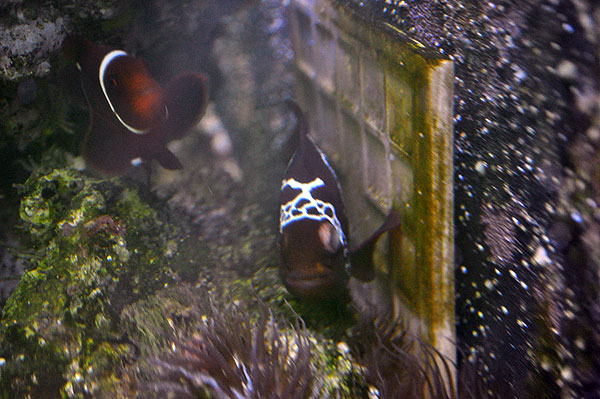
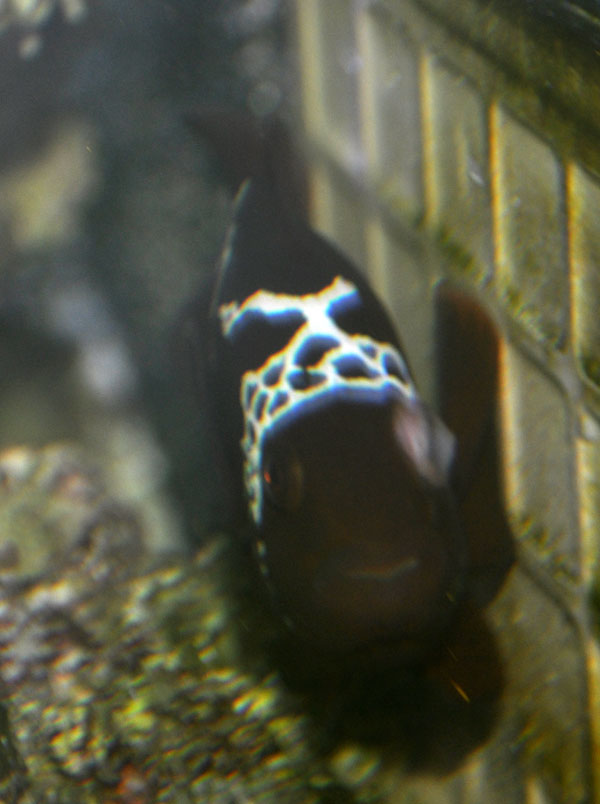
It is now Monday AM, and honestly, things are improving. The appetite of the Lightning Maroon remains strong, which I’ve used to ensure that it continues to feed on the Dr. G’s antibacterial formula. I should preface this by saying that the Lightning Maroon has always been a timid feeder, so food generally has to flow right by its face / into its territory for it to feed. So I’m definitely not following the Dr. G. feeding protocol (as much as they can eat in one minute, every other day).
In talking with the man behind Dr. G’s feeds, the feeds are set up to roughly deliver a “minimum effective dose”. In the case of the anti-parasite Dr. G. formulation (which is laced with Chloroquin Posphate), you can quadruple the feeding regime (twice per day vs. once every other day) and have no ill-effects on the fish (although the Dr. doesn’t recommend that). Knowing how most every antibiotic is normally delivered, it honestly doesn’t make sense to dose every-other day via feed, so I’m going to feed the food once per day to maintain antibiotic levels. It’s worth mentioning that the active ingredients in the Dr. G formula are Kanamycin and Metronidozole.
All in all, this means that I have no less than 4 antibiotics running around. I’ve been talking with two fish vets who I’ll refrain from naming for the time being. One has of course, expressed concern over the “shotgun” approach, understandably so. For me, I’m thinking that the repeat of the Maracyn & Maracyn II are probably of little efficacy, but they were what I had on hand to immediately address the problem. Still, I am more likely to credit the Dr. G’s as the moment, if only because positive progress only started being made once it was introduced to the regime starting on Saturday evening. Still, it could be the other medications.
The main goal here is twofold – #1. effectively cure this latest round of garbage. #2. figure out WHY it’s happening soas to prevent it. As of Monday AM, the eye looks better (less white stuff), so maybe we will get through this latest bout again. But I’m fully wondering what the heck is causing the fish to break down repeatedly. Mechanical damage? Food?
Or could we even be looking at an old-age, immuno-compromized fish? Afterall, they DON’T live forever, they are NOT immortal. Could it simply be that the Lightning Maroon is an older fish, nearing it’s time, and all my drastic measures are simply staving off the inevitable? I hope not.
Despite all this, the male is cleaning the tile like crazy.
I’ve spent all day at a frag swap doing fundraising for our local club, and I come home to see that the antibiotics do not appear to have made any progress at preventing the advancement of this latest round of problems. I took photos, which I will post later, as I am simply exhausted, but the status update is quite simple – I would fully expect that the left eye will be a loss. It is far too diseased. Despite this, the Lightning Maroon is still eating, and was given Antibiotic-laced food I have here from Dr. G’s.
I must admit, logically thinking this through, it should come as no surprise that the antibiotics I have on hand do not appear to be doing anything…because anything that was succeptible was probably killed off in the last round. So the question goes…do I move the fish and try a different antibiotic, or do I draw the line in the sand here. Perhaps the most frustrating part in all of this is that in times like these, I find myself “playing veterinarian”, and yet I’m hardly qualified. And yet, I’m also not sure that an actual trained fish vet could do any better?
It also bears mentioning that this is eirely similar to the eye infection that ultimately took out the original female PNG Maroon. “Why I’m running through the gamut of fatal disease issues I first encountered with other wild maroons from PNG some 2 years in?”, is a very frustrating question to even be asking right now.
Geeze. Not really sure what to say. Things are fine, I go to Chicago for a funeral, I come back, and we have another round of pop-eye? This time, it’s the left eye (first time it was the right). However, there are small white markings on the male too…
Water is pristine. pH 8.2, no ammonia, no nitrite, nitrates minimal (< 2 ppm). A 10 gallon water change (approximately 50%) has been performed, followed by a new round of Maracyn and Maracyn II have been initiated. The big question is WHY. Bacterial infections are normally brought on by things like dirty conditions. Still, even with detectable organic pollution at minimal levels, the tank COULD be running at higher levels of bacteria.
So, the solution may be nothing more than another round of antibiotics with stepped up water changes to act in dilution of any water-borne bacteria that may be the cause of this.
I cannot tell you how incredibly frustrating this is. There’s simply no logical cause to point to. The ONLY thing I’ve thought about is the possibility of frozen food potentially being the cause. If a food had somehow gone bad, it could be reintroducing pathogenic bacteria in elevated levels.
Which means certain foods in my freezer may be discarded.
Of course, this could all be the result of ongoing mechanical damage as these fish continued to clean their nest…these stupid vermitid snails that are all over the tank may be akin to rubbing your face in shards of broken glass. At this point, I have considered the possibility of moving the fish out of the tank for 2 reasons; 1. to jump out of the environment that could be causing infection, and 2. to put them into a potentially less physically abrasive environment.
You heard it here first. Mitch May (better known as the “Booyah” in Booyah’s Clownfish), hats off to you staying on me with the double down. This one goes out to everyone who understood the concept of “patience”, “things taking time”, and “doing it right”. It especially goes out to all of those who believed in the project despite every darn setback and near catastrophe. No doubt, communal faith and good vibes are helping this project along.
Maybe even a gentle nudge from ^ .
5-8-2012, 10 PM – the first ever captive spawning of a PNG Lightning Maroon Clown, now proven female, with a prior proven fertile male PNG White Stripe Maroon Clownfish, Premnas biaculeatus.
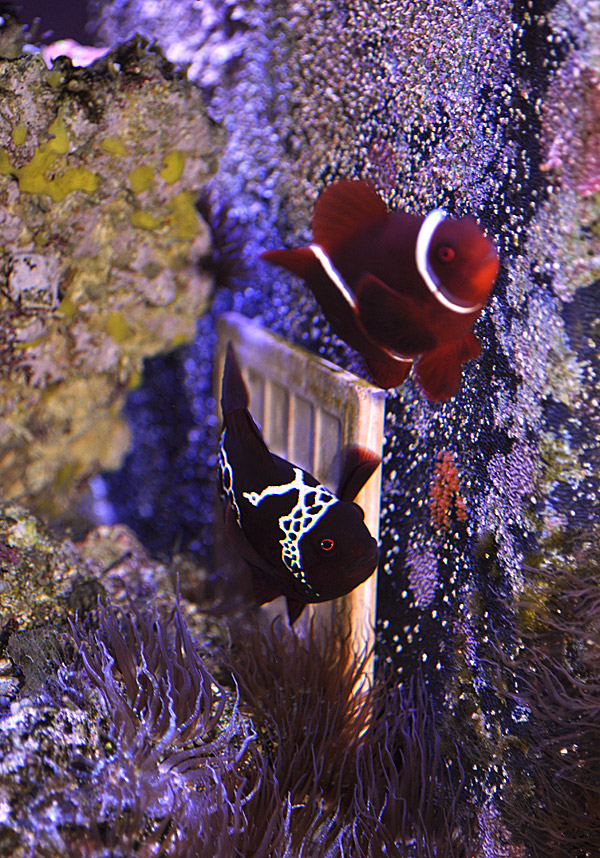
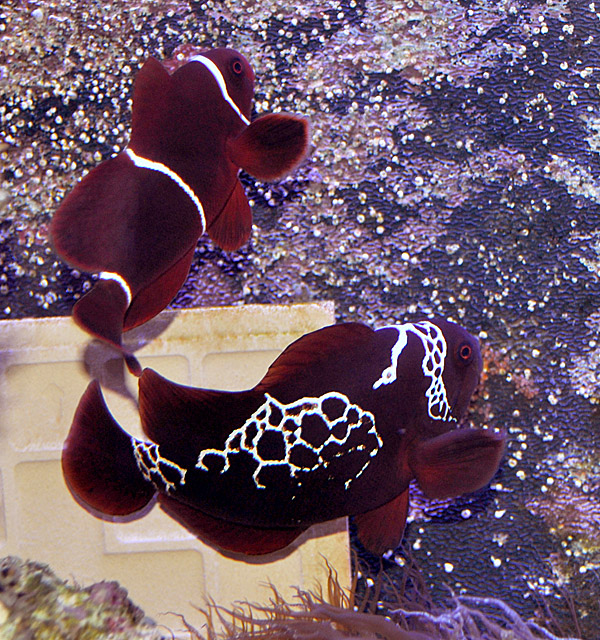
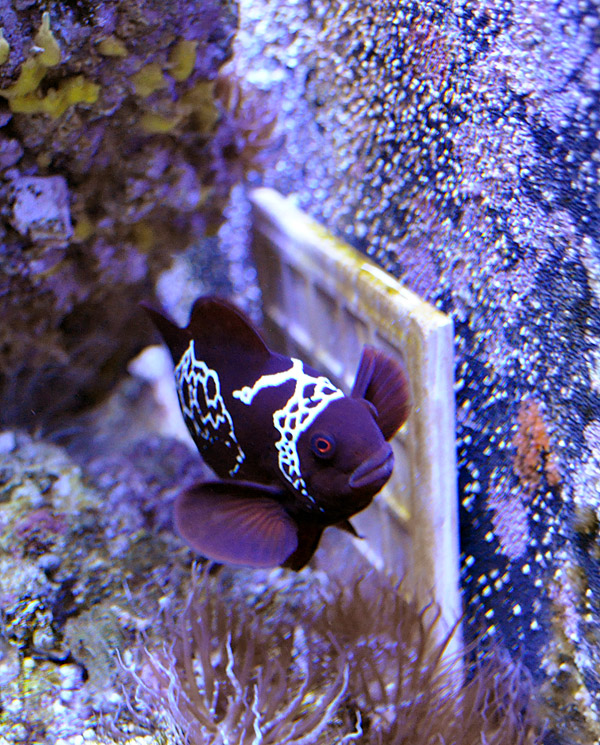
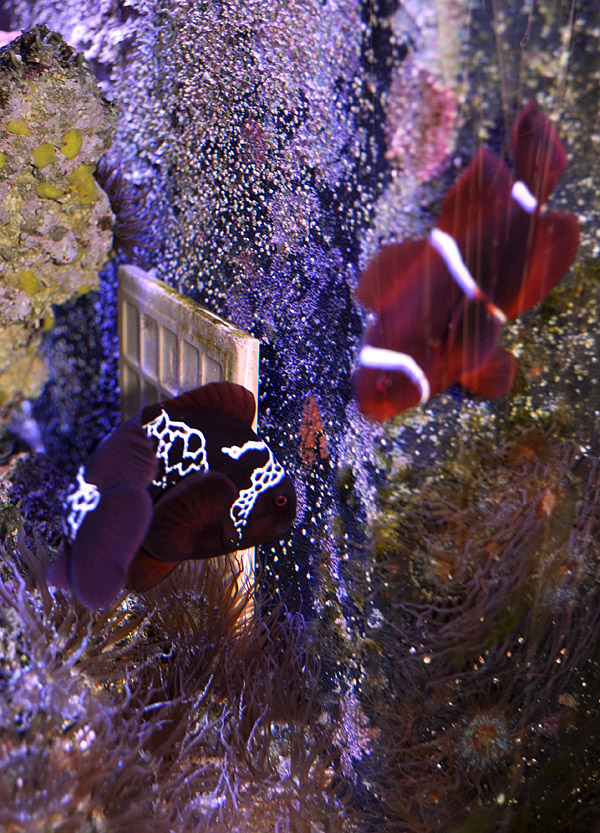
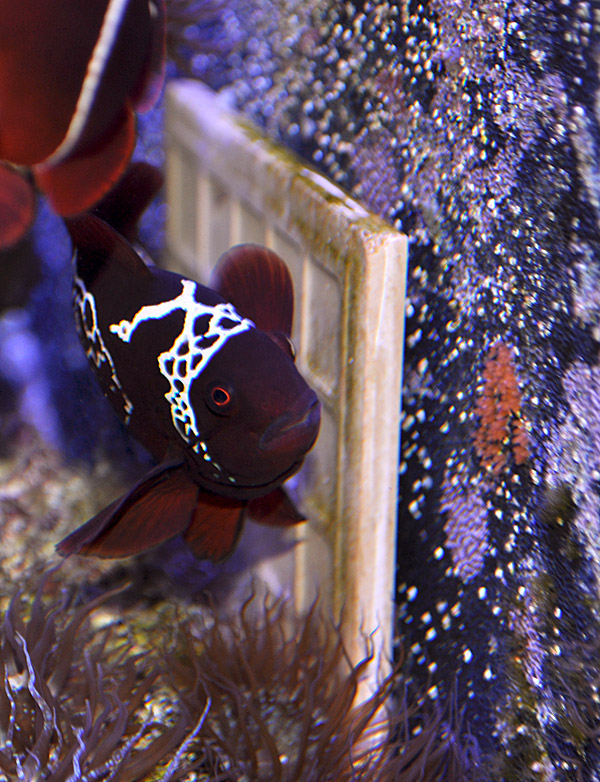
Next time guys, please lay it 1″ to the left.
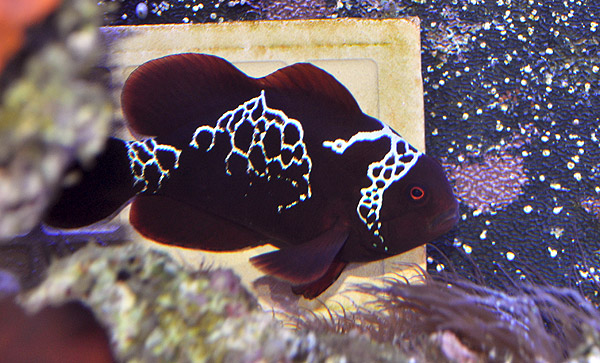
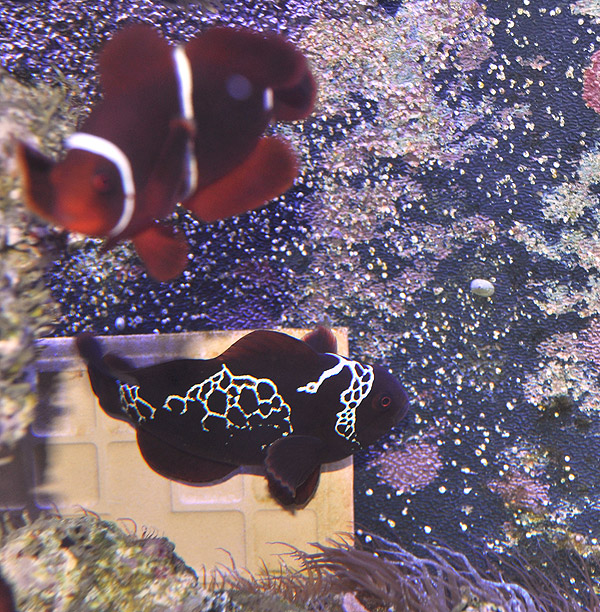
Recent Comments